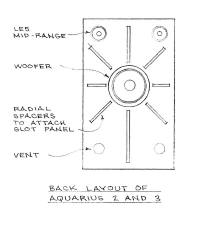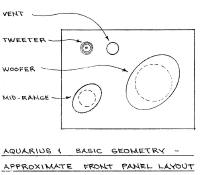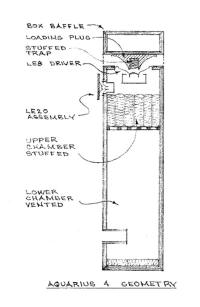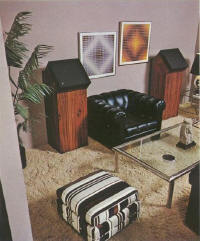|
A Noble Experiment
Illustrated above, is one of the most striking product
lines ever developed by JBL. The Aquarius series was groundbreaking in both
technology and style. Yet with one exception, its existence would be
fleeting. It arrived in the marketplace after a flurry of development
activity but would disappear within two years. What follows is an insight
into the risks and challenges of pushing the state-of-the-art.
Unfortunately, most of the documentation on this project has been lost.
However, the description of events described below is based on the best
information currently available.
DESIGN PRINCIPLE
The Aquarius Series were all based on a common design
principle - slot loaded bass enclosures combined with a widely dispersed
high-frequency response. The intent was to develop a series of loudspeakers
that would have few limitations in room placement and a stereo soundfield
that was largely independent of listener position. The idea of a
widely-dispersed, stereo soundstage had been pioneered by JBL in its
revolutionary Ranger designs (i.e. the Paragon, Metregon and Minigon).
However, these designs required a large, curved, dispersion panel with
unique requirements in enclosure size and geometry that limited their
application. There was a need for a more flexible and inexpensive approach.
Concomitant with this, was a brief vogue for non directional speakers that
developed in the mid sixties. Such designs had been marketed by Harman
Kardon and Stewart Hegeman and were particularly acclaimed in the New York
audiophile market. Finally, JBL was interested in reinvigorating sales with
radically new products that would stake out new ground in form and function.
All of these factors combined in the late sixties to result in the
development of a new series of speakers to be known as Aquarius.
|

Slot
Loading Illustration (click to enlarge)
© and Courtesy George Augspurger
|
The principle of slot loaded enclosures had been
pioneered by Ed May, JBL's head of Product Development. Before joining JBL
in 1959, Ed had been partners with Jack Frazier in the Frazier May
loudspeaker company and they had introduced this concept in the mid fifties.
The illustration at left shows this design in cross-section. The bass driver
was actually front firing and the loading cap and panel were the front face
of the speaker (i.e. the sketch is not meant to illustrate a top firing
speaker).
Ed had tried to interest JBL in this concept shortly
after joining the firm. However, it was not until the fad for dispersed
soundfield speakers in the mid sixties that JBL saw an application. In 1968,
Ed was authorized to begin development of a prototype. The original
prototype was a two-way, stacked coaxial design with the drivers firing
forward into a circular shaped front panel that provided the slot loading.
This design showed promise, but Marketing preferred a rear facing bass
driver with a rear mounted slot panel. This would allow more flexibility in
cabinet design and would arguably couple more effectively with a rear wall.
AQUARIUS 2, 2A
|

Aquarius 2 and 3 Slot Loading
© and Courtesy George Augspurger
|
Design modifications resulted in a second prototype that
would ultimately be refined into the Aquarius 2 and 2A. These would be the
first products developed even though the model names are somewhat
misleading. The sketch at right illustrates the rear slot loading that would
be used for the Aquarius 2 and later Aquarius 3. In the Aquarius 2, a 12"
123A driver was rear mounted in the center of the enclosure. Spacers were
placed radially around this driver and a flat panel was attached to the
spacers to provide the slot loading. Two 5" LE5 midranges were also rear
mounted near the top of the enclosure. They had their own loading plugs
mounted on the diffraction panel. Since the diffraction panel limited
response above 5,000hz, high frequencies were reproduced by a single LE20
tweeter that was direct radiating and mounted on the front panel.
Ed's original Aquarius 2 prototype was considered a sonic
success. It provided a wide, deep soundstage since the slot loaded drivers
produced a dense comb filter that maintained reasonably flat power response
at almost any listening location. The front mounted LE20's would provide a
degree of image localization. However, developing the prototype into a
production system proved extremely difficult. The system was notoriously
sensitive to minor production variances in transducer and enclosure
tolerances. Such variations could change the sonic character from expansive
and balanced to thin and nasal sounding. Eventually, drivers had to be hand
picked and matched to extremely tight tolerances which added significantly
to production costs.
AQUARIUS 1
|

Aquarius 1 Slot Loading
© and Courtesy George Augspurger
|
Development proceeded on the Aquarius 1 at the same time
as the 2 and 2A. The Aquarius 1 was modeled on the successful 4310 monitor
and subsequent L100. The midrange and high frequency drivers were the same
LE5 and LE 20 with the substitution of a 10" LE10 bass driver in place of
the 12" 123A. The drivers were all front mounted and individual diffraction
panels were designed for the bass and midrange. The design of these panels
evolved empirically and resulted in elliptical shapes that are illustrated
in the sketch at left. It is interesting that this design proved to be the
least prone to production variations and was arguably the best sounding of
the series.
AQUARIUS 4
Development of the Aquarius 1, 2 and 2A were virtually
complete when Ed May left JBL in 1970. Refinement of the partially complete
Aquarius 4 fell on the shoulders of George Augspurger, who was then
Technical Director of JBL
|

Aquarius 4
Geometry
© and Courtesy George Augspurger
|
The original concept for this speaker was a very compact,
columnar design that top mounted an LE8T. This driver operated full range
and fired into a conical diffuser that would provide 360 degree dispersion.
This concept was not new and continues to find resurgence every few years.
However, it proved difficult to adapt to the chosen driver.
The LE8T was not suited to slot loading. The design had
to be modified so that the loading operated more as a radial horn. Further,
it was discovered that the system had to be baffled above and below the
mouth so that an empty top chamber was added to the enclosure. Even with
this added baffling, the short horn generated a pronounced resonance at
around 1000hz . This was finally mitigated by drilling out the center of the
conical loading plug to create a quarter-wave stub. However, this solution
introduced a new problem. The quarter-wave trap dissipated frequencies above
5000hz so that high frequency augmentation was required. This was provided
by an LE20 that was rear firing and had it's own circular slot loading to
make it onmidirectional.
Equally challenging was engineering the system to develop
a reasonable low-frequency response. Originally, the column below the driver
was designed as a simple vented enclosure. However, this space had the
geometry of an organ pipe and sounded like one. Extended trial and error was
required to develop a solution consisting of a stuffed chamber open to a
vented space below. This provided usable low-frequency extension to 40hz.
AQUARIUS 3
|

Aquarius 3
© Harman International, Courtesy John
Edwards
|
The final speaker to be developed in the series was the
Aquarius 3. This would be the sole responsibility of George Augspurger and
would be the most ambitious design of them all. The desire was to develop a
nondirectional speaker for the high-end market segment. It would use a large
bass speaker in combination with a compression driver typical of such
contemporary systems as the Olympus. However, all of the drivers would
employ some form of indirect dispersion.
The starting point was a scaled-up version of Ed May's
prototype for the Aquarius 2. The same configuration of bass and midrange
drivers was used only the 12" bass driver was replaced with the 14" LE14A.
An LE85 compression driver would be front mounted in combination with a
radial horn that would be developed specifically for this system. The new
horn would be designed for as broad a dispersion pattern as possible and
would require pioneering research and development.
|

Aquarius 3 Horn
Geometry
© and Courtesy George Augspurger
|
George's experiments with horn design began
inauspiciously using teakwood serving trays, around 18" in diameter, from a
local home supply store. The first horn worked fairly well, but response was
noticeably different on and off axis. George addressed this by cutting
tapered, radial slots in the dish to generate a more diffuse sound source.
This idea was prompted by Karlson's radial slot concept, popular in the
1950's. The slotted horn was much closer to a hemispherical source, with
very little loss in overall efficiency.
Mounting the horn on the front panel, as Ed May had
originally envisioned for the Aquarius 2, worked pretty well but there was a
noticeable change in response directly on-axis. Mounting the horn on the top
panel, as one would expect a radial horn to be oriented, smoothed out the
coverage pattern but didn't sound as good. The best results were obtained by
tilting the horn at 45 degrees, which accounts for the distinctive letterbox
shape of the enclosure.
Modifying the back panel to accommodate the larger LE14A
driver was relatively straightforward. However, George soon discovered that
slot loading presented a unique set of issues. This loading effectively
added significant mass to the cone at low frequencies. With the bass reflex
vents inside the slot, there was additional mutual coupling between woofer
and vents. As a result, the woofer cone had to be lighter and the suspension
stiffer than a standard JBL LE14A. Even so, bass response was considerably
more extended than conventional JBL systems of similar size and the
diffraction panel naturally attenuated the midrange response to provide an
easier match between drivers.
In the opinion of its designer, the Aquarius 3 was a very
good sounding speaker that could hold its own with contemporary JBL systems.
In particular, its solid and extended bass response was arguably superior to
most JBL speakers. To this day, George Augspurger regrets not having
purchased a pair for personal use.
MARKET IMPACT
The Aquarius 1, 2, 2A and 4 were introduced in 1970.
Their unique styling and engineering generated significant buzz within the
industry. However, this did not translate into sales. The Aquarius 2 and 2A
were a particular disappointment. It quickly became apparent that their
relatively high costs, both in development and production, would not be
recouped. They were cancelled before the end of the year. The failure of
these speakers led to the cancellation of the Aquarius 3 even before
production could begin. Only four development pairs were ever produced
before the program was terminated. The Aquarius 1 and 4 would soldier on
into the 1971 production year. The Aquarius 1 was produced in a limited
production run and was discontinued after this run sold out. Only the
Aquarius 4 would continue in production for the next five years.
|

L120
Aquarius Q
© Harman International, Courtesy Ed
Lacinski
|
The relative success of the Aquarius 4 was interesting in
light of the fact that it arguably had the most compromised performance of
the series. However, in its favor were a compact form factor and timing. The
extremely small footprint of the columnar design lent itself to great
flexibility in placement in any number of home environments. The early
seventies saw a briefly-lived technology development that accentuated this
advantage. This was the introduction of quadraphonic sound. The need to
accommodate four speakers for quadraphonic reproduction made the small
footprint of the Aquarius 4 even more desirable. In fact, the relative
success of this design led to a subsequently larger variant that was
introduced in 1975. This was the three-way L120 Aquarius Q. However, by the
mid seventies, the quadraphonic phenomenon was on the wane due to market
segmentation caused by a lack of standards. By 1977, all of the Aquarius
series would be discontinued.
Nonetheless, the legacy of the Aquarius series would
continue into the 1990's. The Aquarius 4 would be redesigned and
reintroduced as the S2 in the mid 1980's. The single LE20 in the original
design was replaced with four 1" tweeters placed in the corners of the
low-frequency slot. The LE8T was replaced with the 108H bass driver. The
enclosure design and dimensions were virtually identical to the original.
The S2 was introduced with a companion subwoofer called the S1. This mounted
another 108H bass driver in a similarly dimensioned columnar enclosure. The
last incarnation of the Aquarius concept was developed strictly for the
Asian market in 1990 as the S119. This was virtually identical to the S2 but
used shielded drivers and was produced in a gloss finish.
ANALYSIS OF MARKET FAILURE
The disappointing sales of the Aquarius series were due
to three primary factors. First, the design concept was arguably a
technological step backwards. Rather than raising the level of sonic
accuracy, it was meant to address deficiencies in the recording process that
would ultimately be rectified as the industry matured. It must be remembered
that this was the era of "ping pong" stereo. Rather than attempting to
capture a three-dimensional soundfield, mixes were routinely engineered to
just place separate instrument tracks on separate channels. On these
recordings, a diffuse soundfield could artificially create a sense of space.
Second, there was insufficient time for development. This
was compounded by the desire to introduce a whole family of unusual
loudspeakers without allowing enough time to thoroughly engineer and test
the systems. Given another six months, the sound quality of the Aquarius 2
and 4 could have been greatly improved.
Finally, there was a problem posed by the radical
departure in sound compared to previous JBL products. JBL was a successful
high-end manufacturer with a reputation for a distinctive sonic character.
The Aquarius series was considered by many to be too much of a deviation
from this character. It therefore failed to find immediate acceptance in its
existing market niche. Further, the diffuse sound concept was difficult to
set up in a typical listening room, and almost impossible to demonstrate
effectively in a dealer's showroom. This made it difficult to appeal to a
new market niche.
The lack of market acceptance was disappointing, but it
was not disastrous for the company. At the time. JBL was a small, high-end
company that operated without marketing studies or focus groups. A new
design was sent to dealers and it either succeeded or failed. The fact that
the Aquarius concept failed was unfortunate, but it was taken in stride. In
fact the introduction of the Aquarius series coincided with the introduction
of the L100. That speaker would go on to be the most successful speaker ever
produced by any manufacturer in its day.
© 2001 Don McRitchie
based on information provided
by George Augspurger
|